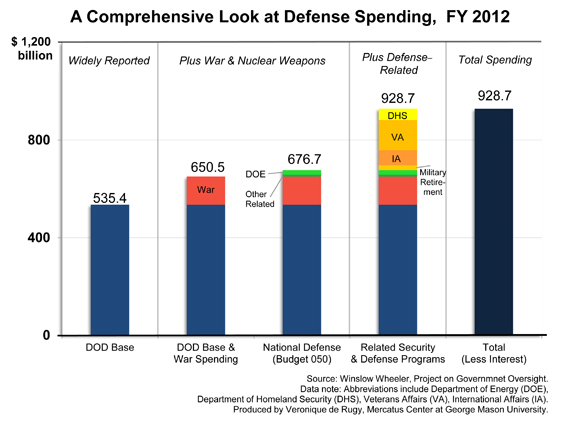- | Government Spending Government Spending
- | Data Visualizations Data Visualizations
- |
A Comprehensive Look at Defense Spending, FY 2012
How much are we actually spending on national security and defense–related programs? A whole lot more than you think.
How much are we actually spending on national security and defense–related programs? A whole lot more than you think.
This chart puts into perspective the amount of spending that is not being accounted for in widely cited figures by the Pentagon (DOD) and the Office of Management and Budget (OMB). Using data calculated by Winslow Wheeler of the Project on Government Oversight, line items from other areas of the federal budget relevant to defense and security issues are added to the FY 2012 base. The findings suggest that reported defense spending figures underestimate the overall cost of defense and national security programs by up to $400 billion in FY 2012.

The most widely reported defense spending estimate is the Pentagon’s $530 billion base budget; however this figure doesn’t account for war funding, which has been above $100 billion each year recently. When war funding is added, the total jumps to about $650 billion. This figure has already begun to decrease as the United States withdraws from the wars in Iraq and Afghanistan.
Additionally, the DOD base doesn’t account for the nuclear weapons research and technology that falls under the Department of Energy’s budget. After we account for both nuclear weapons and war spending, we establish the amount that is reported by the OMB for National Defense (or Budget Function 050). Adding DOE nuclear programs and other related defense activities takes the total up to $676 billion.

While the majority of defense spending takes place in the Pentagon budget or National Defense budget function, there are many other cases of spending related to national security and defense:
- $125 billion to Department of Veterans Affairs to care for wounded or retired military veterans
- $61 billion to International Affairs for additional war funding, weapons training to foreign militaries, and peacekeeping operations (Note that there are nondefense-related items in this amount, such as operating US embassies and consulates and normal diplomatic operations.)
- $46 billion to Department of Homeland Security for responding to terrorism and natural disasters
- $21 for retirement costs to DOD civilian workers who draw pensions and benefits.
After accounting for the outlined programs above, a more comprehensive defense spending figure comes out to nearly $930 billion. This amount does not include the additional interest costs on the debt, which would only add to the spending amount.

